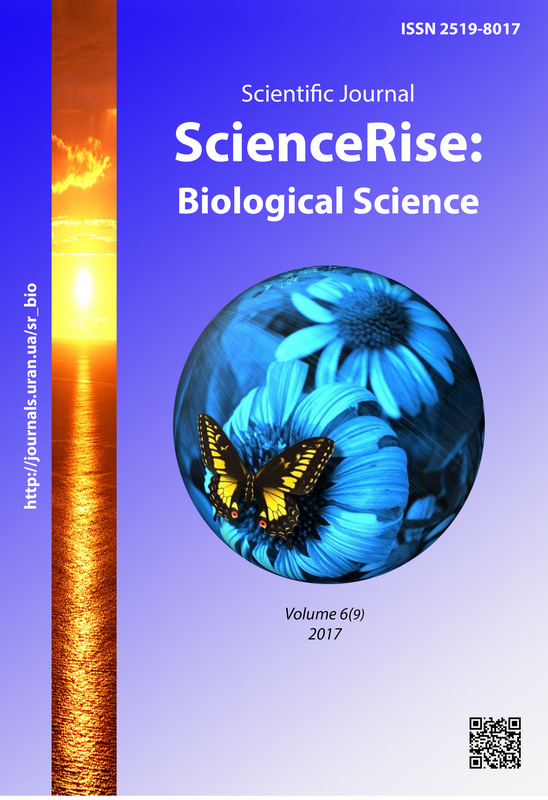Distribution, biology and status of population of Neogobius Melanostomus legs and thriver (Zosterisessor Ophiocephalus) in Shabolatsky liman
DOI:
https://doi.org/10.15587/2519-8025.2017.119833Keywords:
water body transformation, neogobius, melanostomus legs, thriver, population structure, age, size-massAbstract
There was studied the modern condition of populations of main industrial species of goby fish in Shabolatsky liman. The ecological catastrophe took place in 1992. As a result of the global suffocation, mass death of bottom fish (especially, gobies) was observed in the Southern-Western part of the water body. In the further period the ecological condition of Shabolotsky liman worsened because of the limited link with the sea. Several physical-chemical parameters of the water environment changed: salinity increased, organic content in water and bottom sediments grew, transparency decreased. The oxygen content in the near-bottom horizon decreased, hydrogen sulfide emissions were observed.
The anthropogenic transformation of the liman ecosystem influenced qualitative and quantitative indicators of main groups of hydrobionts. The biological diversity and biomass of animal plankton and zoobenthos decreased, associations of macrophytes disappeared, the bloom of liman was observed the whole year round as a result of the progressing euthrophication.
The renewal of the liman ecosystem took place only in 1997-2003. The reconstruction and continuous work of channels that connect Shabolatsky and Dnestrovsky limans and the regular work of a maritime channel provided normalization of the hydrologic-hydrochemical regime, restoration of biocenoses and forage reserve.
The anthropogenic transformation of the ecosystem of Shabolatsky liman was reflected on population characteristics of melanostomus legs and thriver – the most mass species of neogobius in the liman. Their distribution in the liman water area, age and size-mass structure of populations, fatness, reproduction effectiveness and nutrition features changed. Most of these indicators differ from the previous period today. Along with it the received characteristics of neogobius melanostomus legs and thriver testify to the fact that their population in Shabolatsky liman is gradually renewed last years and its condition essentially improves
References
- Demchenko, V. O. (2004). Ikhtiofauna ta pokaznyky yakosti vody molochnoho lymanu v zviazku z rybohospodarskym vykorystanniam vodoimy. Kyiv, 20 .
- Severo-zapadnaya chast' Chernogo morya: biologiya i ekologiya (2006). Kyiv: Naukova dumka, 701.
- Dimitriev, Ya. I. (1979). Ispol'zovanie lagun Chernogo morya v rybohozyaystvennyh tselyah. Kishinev: Shtiintsa, 174.
- Starushenko, L. I., Bushuev, S. G. (2001). Prichernomorskie limany Odesshchiny i ih rybohozyaystvennoe ispol'zovanie. Odessa: Astroprint, 151.
- Shekk, P. V., Kryukova, M. I. (2010). Otsenka kormovoy bazy i perspektivy ispol'zovaniya SHabolatskogo limana dlya pastbishchnoy marikul'tury. Visnyk zaporizkoho natsionalnoho universytetu, 1, 1126–1135.
- Diripasko, O. A., Zabroda, P. N., Bazhan, A. A. (2012). Bychki Azovskogo morya i perspektivy ustoychivosti zapasov v usloviyah intensivnoy ekspluatatsii resursa. Sbornik nauchnyh trudov NIAM, 75–89.
- Shekk, P. V. (1982). Povyshenie promyslovoy produktivnosti pribrezhnoy zony severo-zapadnoy chasti Chernogo morya i Prichernomorskih limanov. «Sostoyanie zapasov bychkov v limanah severo-zapadnogo Prichernomor'ya i ih ratsional'noe ispol'zovanie» Otchet o vypolnenii NIR v 1975–1976 gg. Odessa, 80.
- Volya, E. G. (2000). Vliyanie nekotoryh antropogennyh faktorov na ekosistemu Shabolatskogo limana. Ekologicheskie problemy gorodov, rekreatsionnyh zon i prirodoohrannyh territoriy: tez. dokl. 3-y mezhdunar. nauch. -prakt. konf. Odessa, 52–56.
- Volya, E. G., Druchin, A. I. (1999). Izmenenie nekotoryh sostavlyayushchih bioticheskoy komponenty Shabolatskogo limana, proisshedshie v rezul'tate ekologicheskoy katastrofy 1992 goda. Sohranenie bioraznoobraziya basseyna Dnestra: mater. mezhd. konf. Kishinev, 45–47.
- Korenyuk, A. V., Zamorov, V. V. (2000). Sostoyanie makrozoobentosa Shabolatskogo limana v vesenne-letniy period 1998 goda. Ekologiya moray, 52, 5–8.
- Pryahin, Yu. V., Shnitskiy, V. A. (2006). Metody rybohozyaystvennyh issledovaniy. Krasnodar: Kubanskiy gosuniversitet, 214.
- Pravdin, I. F. (1966). Rukovodstvo po izucheniyu ryb. Moscow: Pishchevaya promyshlennost', 376.
- Chugunova, N. I. (1959). Rukovodstvo po izucheniyu vozrasta i rosta ryb. Moscow: AN SSSR, 164.
- Lakin, G. F. (1980). Biometriya. Moscow: Vysshaya shkola, 293.
- Zamorova, M. A., Zamorov, V. V. (2011). Razmerno-vozrastnoy sostav bychka- kruglyaka v Odesskom zalive (Chernoe more) v 2007 g. IV mizhnarodna ikhtiolohichna naukovo-praktychna konferentsiya Suchasni problemy teoretychnoi ta praktychnoi ikhtiolohiy: tezy. dopov. Odessa: Feniks, 107–110.
- Kuz'minova, N. S., Kovyrshina, T. B., Tertychniy, S. P. (2013). Populyatsionnye harakteristiki bychka-kruglyaka v Azovskom more v 2011–2012 gg. Nauk. zapysky. Ternopilskoho nats. ped. Un-ta. Seriya: Biolohiya, 2 (55), 78–84.
- Demchenko, V. A., Mityay, I. S. (2001). Sovremennoe sostoyanie nekotoryh massovyh vidov bychkov (sem. Gobiidae) v Molochnom limane i prilegayushchih rayonah Azovskogo moray. Ekologiya moray, 56, 5–8.
- Smirnov, A. I. (1986). Okuneobraznye (Bychkovidnye). Vol. 8. Fauna Ukrainy. Kyiv, 7–173.
- Tarnavskiy, M. P. (1960). Kambala-glossa, bychki i drugie ryby v promysle Molochnogo limana. Trudy instituta gidrobiologii An USSR, 35, 213–225.
- Dolgiy, V. N. (1962). Materialy po biologii bychka-travyanika Zosterisessor ophiocephalus (Pallas) v usloviyah limanov Tuzlovskoy gruppy. Uch. zap. Kishinev. un-ta. Ser.: Biol., 62 (1), 129–135.
Downloads
Published
How to Cite
Issue
Section
License
Copyright (c) 2017 Marina Burgaz

This work is licensed under a Creative Commons Attribution 4.0 International License.
Our journal abides by the Creative Commons CC BY copyright rights and permissions for open access journals.
Authors, who are published in this journal, agree to the following conditions:
1. The authors reserve the right to authorship of the work and pass the first publication right of this work to the journal under the terms of a Creative Commons CC BY, which allows others to freely distribute the published research with the obligatory reference to the authors of the original work and the first publication of the work in this journal.
2. The authors have the right to conclude separate supplement agreements that relate to non-exclusive work distribution in the form in which it has been published by the journal (for example, to upload the work to the online storage of the journal or publish it as part of a monograph), provided that the reference to the first publication of the work in this journal is included.









